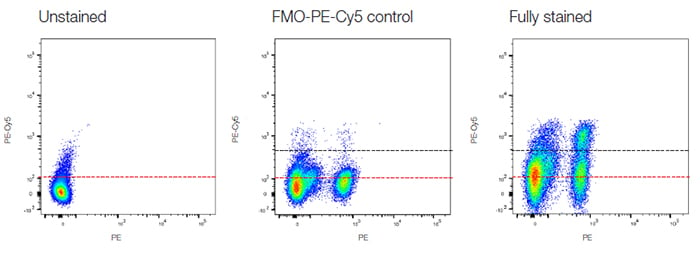-
US | en
- Products
- Applications
- Flow Cytometry
- Flow Cytometry Explained
- Flow Cytometry Basics Guide
- Chapter 4 - Controls in Flow Cytometry
- Fluorescence Minus One Controls

Fluorescence Minus One Controls
Fluorescence minus one (FMO) controls are important when building multicolor flow cytometry panels as they will help you determine where your gates should be set. This is particularly important when identifying a positive from a negative population and when the expression levels are low. When acquiring data, there is fluorescence spread, especially with brighter fluorophores, which is particularly noticeable after compensation and cross-laser excitation. Careful experimental design and avoiding channels which have a large amount of spreading will help reduce this influence, but FMO controls are still important.
FMO controls are the experimental cells stained with all the fluorophores minus one fluorophore.
FMO Examples
An example of an FMO matrix is shown below in Table 4. Figure 22 shows how the fluorescence spread from other channels can affect the data ensuring you can position your gates accordingly, taking into account the fluorescence spread.
FMO controls should be done for all the fluorophores in your panel when starting a new multicolor experiment. This will then allow you to assess the spread of all the fluorophores into your missing channel and set your gates accordingly.
Table 4. FMO Matrix
Tube |
FITC |
PE |
PE-Cy5 |
PE-A750 |
|---|---|---|---|---|
|
Unstained |
- |
- |
- |
- |
|
FITC – FMO |
- |
+ |
+ |
+ |
|
PE - FMO |
+ |
- |
+ |
+ |
|
PE-Cy5 - FMO |
+ |
+ |
- |
+ |
|
PE-A750 - FMO |
+ |
+ |
+ |
- |

Fig. 22. FMO controls to determine fluorescence spread. Dot plots of multicolor flow cytometry showing the fluorescence spread into the PE-Cy5 channel shown by the FMO control compared to an unstained control. Black dotted line represents FMO gating boundary compared to unstained boundary in red.
Alexa Fluor is a trademark of Life Technologies Corporation
Cy is a trademark of GE Healthcare group companies.
